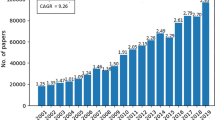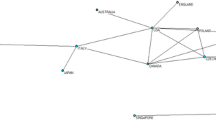Abstract
Science in the last few years has become increasingly global and collaborative. The number of internationally coauthored papers has been increasing steadily. We have counted internationally jointly authored papers involving authors from the advanced countries and the Third World countries, usingSCI 1991. We have looked at the number of papers resulting from collaboration among authors residing in the countries of the North (e.g. EC and OECD countries), authors residing in the South (e.g. India and Bangladesh, Mexico and Brazil, China and Pakistan) and papers resulting from collaboration between authors residing in the countries of the South and the North (e.g. India and UK, China and USA). Despite its late start, China has published many more collaborative papers with most Asian countries and the advanced countries of the West except the UK than India — confirming the effectiveness of the open door policy of post-Mao China. Both India and China collaborate with USA much more often in physics than in other areas, followed by clinical medicine. However, India collaborates more with USA in chemistry than China. In Indo-US and Sino-US collaborations, collaborating institutions are mostly universities and institutes of higher learning in India and USA, whereas in China several institutions under the Academies also take part. The percentage of collaborative papers involving authors from India is even smaller than the percentage of journal articles originating from India. In general, papers resulting from international collaboration appear in better journals and are cited more often than papers that are the outcome of local research.
Similar content being viewed by others
References
OECD,Science and Technology Policy: Review and Outlook 1991, Paris 1992, pp. 69–79.
R. Smith, European research: Back to pre-eminence?British Medical Journal, 304 (1992) 899–903.
D. De Solla Price, E. D. deB.Beaver, Collaboration in an invisible college,American Psychologist, 21 (1966) 1011.
D. deB.Beaver, R. Rosen, Studies in scientific collaboration: Part I. The profile of origins of scientific co-authorships,Scientometrics, 1 (1979) 65–84.
D. deB.Beaver, R. Rosen, Studies in scientific collaboration: Part II. Scientific co-authorship, research productivity and visibility in the French scientific elite 1799–1830,Scientometrics, 1 (1979) 133–150.
D. deB.Beaver, R. Rosen, Studies in scientific collaboration: Part III. Professionalism and the natural history of modern scientific co-authorship,Scientometrics, 1 (1979) 231–245.
J. D. Frame, M. Carpenter, International research collaboration,Social Studies of Science, 9 (1979) 481–497.
K. Subramanyam, Bibliometric studies of research collaboration: A review,Journal of Information Science, 6 (1) (1983) 33.
A. Schubert, T. Braun, International collaboration in the Sciences, 1981–1985,Scientometrics, 19 (1990) 3–10.
Y. Okubo, An overview of bibliometric methods and their use in description of internationalisation of science, Report to OECD, August 1990.
Y. Okubo, J. F. Miquel, International scientific collaboration of Japan — Co-authorship analysis,Journal of scientific Policy Research Management, 6 (1991) 261–280.
N. Narvaez-Berthelemot, L. P. Frigoletto, J. F. Miquel, International scientific collaboration in Latin America,Scientometrics, 24 (1992) (373–392).
G. Czapski, Scientific activity in Israel: publications and citations, in:Studies in Science Policy,B. C. Peritz (Ed.)
G. Czapski, A. Frankel, D. Kohn, A. Shokam, Cooperation between Israeli and foreign researchers,Scientometrics, 25 (1992) 381–400.
Y. Okubo, J. F. Miquel, L. P. Frigoletto, J. C. Dore, Structure of international collaboration in science: typology of countries through multivariate techniques using a link indicator,Scientometrics, 25 (1992) 321–351.
F. Narin, Evaluative bibliometrics: The use of publication and citation analysis in evaluation of scientific activity, NTIS Report, PB-252, 339, 1976.
Institute for Scientific Information Inc., Philadelphia,Science Citation Index 1991: Guide and List of Source Publications.
American Chemical Society,Chemical Abstracts Service, Annual statistical summaries for 1985 and 1991.
S. Arunachalam, U. N. Singh, Rita Sinha, The sleeping dragon wakes up. A scientometric analysis of the growth of science and the use of journals in China,Current Science, 65 (1993) 809.
S. Arunachalam, Science in the European Community — the extent of collaboration,Current Science, 63 (1992) 56–58.
Data from LEPI-CNRS MEV-MAC database, CourtesyY. Okubo.
National Science Foundation, Indian scientific strengths: Some advantageous areas for increased US collaboration, 1987.
German Foundation for International Development — United Nations Centre for Science and Technology for Development, International cooperation in science and technology for development: Future options. Proceedings of the Interregional Meeting, Feldafing, Federal Republic Germany, Feb 23–25, 1989.
J. Mullin, Technology policy and university-industry links. Paper presented at: Technology, Commercialisation and R & D: International Workshop on Industry-university Interaction, Bangalore, India, June 24–26, 1992.
R. Conroy, Science and Technology in China. OECD Development Centre, Reprint Series — No. 9, 1989.
M. S. Swaminathan, The road from Rio: China shows the way,The Hindu, Madras (6 June 1993), Magazine I.
Wu Yishan, China: Also a power in science and technology?,Current Science, 65 (1993) 807.
C. N. R. Rao, Outgoing president's address to the Indian National Science Academy, Bangalore, January 2, 1987; seeScience Today, Bombay (Feb. 1987) 8–9.
C. R. Bhatia, Science and technology in a poor country,Current Science, 64 (1993) 549.
Author information
Authors and Affiliations
Rights and permissions
About this article
Cite this article
Arunachalam, S., Srinivasan, R. & Raman, V. International collaboration in science: Participation by the Asian giants. Scientometrics 30, 7–22 (1994). https://doi.org/10.1007/BF02017209
Received:
Issue Date:
DOI: https://doi.org/10.1007/BF02017209




